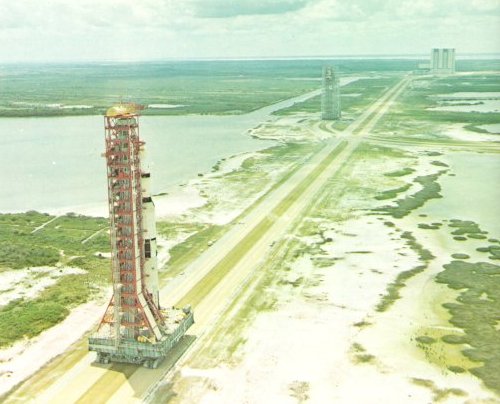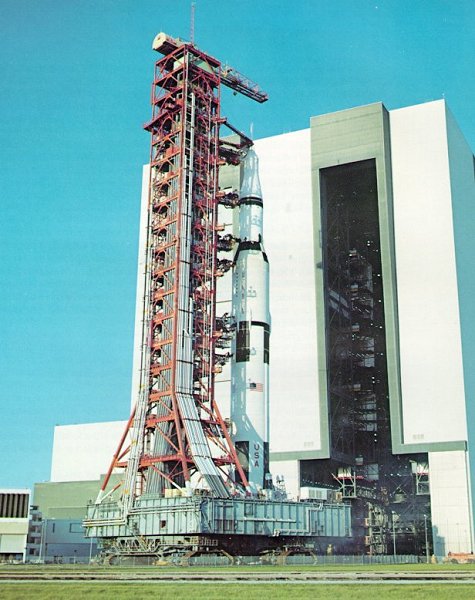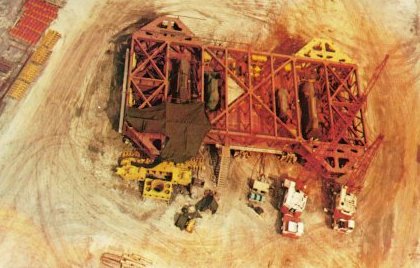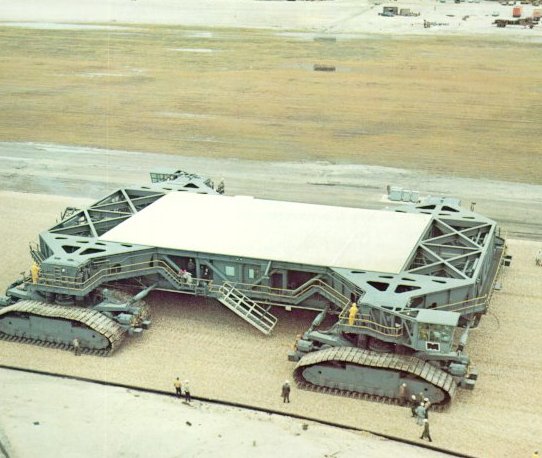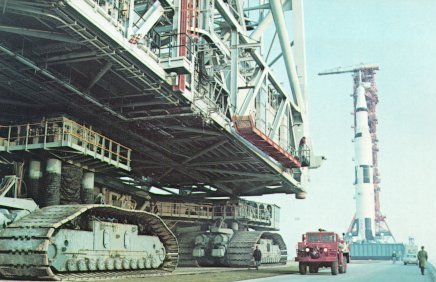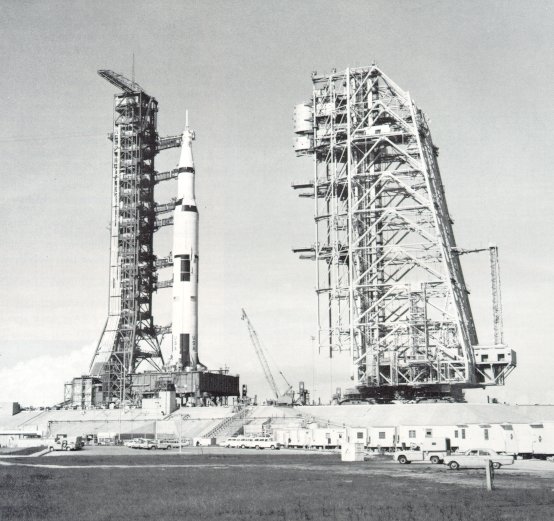Apollo Expeditions to the Moon
KEEPING VERTICAL ON THE MOVE
The crawler also required a leveling system that would keep the Saturn V to
within one degree of absolute vertical. The sensing system depended on two
manometers - each 135 feet long, extending like an X from corner to corner under the
platform; if they showed the deck was out of level
by even half an inch, it was corrected
by hydraulically raising or lowering one or more of the corners. Adjustments
were made many times during the trip from the VAB, especially when the crawler
climbed the five-degree incline leading up to the pad.
One of the great days in the history of the Cape was May 25, 1966, when Apollo-Saturn
500-F-a test vehicle built by Marshall Space Flight Center that duplicated
everything except engines and spacecraft, of which it had none - rolled out of the
VAB on the crawler and moved at glacial speed to Pad A, gleaming in the brilliant
sunshine. It was the biggest rocket ever built by man, dummy though it was, and up
there, safely on the pad, Saturn V was something to behold. It was five years to the
day since President Kennedy had proposed landing a man on the Moon and returning
him safely to Earth. When the crawler put the launcher on its supports that afternoon,
one of the men who (along with me) breathed easier was Don Buchanan, on whose able
shoulders the design responsibility for both the crawler and launcher had been placed
three years before.
Dr. Debus had been wearing two hats, one as director of this growing Center,
the other as director of launch operations. With the pressure mounting he decided to
doff one of them, so two months after the roll-out of 500-F, I was appointed Director
of Launch Operations, an assignment I held until after Armstrong, Aldrin, and Collins
demonstrated in July 1969 that Apollo was a success.
| | |
The first Saturn V space
vehicle and its Mobile
Launcher on their way out
to Launch Pad A atop a
transporter. The pad is 3 1/2
miles east of the VAB. The
Mobile Service Structure is
parked at the loop where
the crawlerway to Pad B
diverges to the north
(right). The barge canal to
the VAB runs parallel to
the main crawlerway.
|
| | |
The last Moonbound Apollo-Saturn rolls slowly
out of the huge VAB into the morning Sun. Each
door of the four VAB bays opens 456 feet high
and 75 feet wide. The VAB encloses a volume
of 129,482,000 cubic feet. But the tale that
clouds form inside and rain falls is only folklore.
|
In the very early days there had been a lot of hit-and-miss, seat-of-the-pants business
in launching rockets - and, insofar as the public was concerned, a lot of black
magic. Some odd things happened. I recall a Redstone launch in May 1954, when I was
still in the Army, that we had to delay because somebody reported a fishing skiff
offshore, a dangerous place to be at liftoff time. We sent out some guards to warn the
fishermen out of the way. By the time the guards reached the spot they found the
boat was up on the beach and the fishermen were gone. Then we had to send someone
to find the guards and tell them to come back, and that took another hour before we
could launch. At other times the count would be held up because diesel engines powering
a tractor didn't work, or a key to the tractor had been lost.
But we learned as we traveled this long road. The really big event was the launch
of the first Saturn V, November 9, 1967, which we designated Apollo 4. To me that
was the real mark; its success meant we were really going to make the Moon landing.
To bring together the massive hardware and the complex ground equipment exactly
when we wanted to was an achievement. You don't look at a thing like the Saturn V
without a lot of humility in your heart. Consider the three stages, the Instrument Unit,
the vast amount of automation, the many computers on the ground and in the stack,
the swing arms, the hold-down arms, the propellant loading system - all these were
intricate and potentially troublesome elements that had to be brought up to speed,
and at a vast launch complex that was being used for the first time.
| | |
Mining technology for a Moon launch. Utilizing power shovel design concepts,
two 131-foot long, 3000-ton, track-mounted crawlers were
built to transport the MSS and an assembled
Apollo-Saturn V from the VAB to the pad,
and back should hurricane weather threaten a launch.
|
| | |
Shipped in sections from Marion, Ohio, the 114-foot wide,
X-framed crawlers were assembled on site at the Cape.
Four large diesel engines coupled to six electrical generators power crawler's
motive, leveling, jacking, and steering systems.
Operator's cab, lower right is matched diagonally
by another.
|
We kept having problems during the Countdown Demonstration Test in September
and October; it was scheduled for three and one-half days, but lasted 23. We'd
go so far, and we'd find a leak. We had ground equipment problems, then procedural
problems; batteries failed, and pressure gauges developed faults. But these problems
melded our team, as in a cauldron. Under pressure our people came of age, in the
firing room and on the pad. When the five engines of Saturn 501 fired up at 7 a.m. we
had confidence, which proved to be justified.
| | |
The Mobile Service Structure coming down from the launch pad.
About 11 hours before launch,
a crawler carries the MSS back from the pad to its parking
area. Although the crawler is descending
a 5-degree slope, the hydraulic cylinders,
shown here fully extended, keep its platform level.
|
| | |
A driver eases the crawler beneath a Mobile Launcher;
once in place it lifts up both launcher
and space vehicle. The driver, who wears a seat belt for his 1-mph trip,
is like the helmsman of a
ship; the total crawler crew, in control and engine rooms
inside, is about 15 men.
|
By the time of Apollo 11, the number of printed pages, including interface
control documents, that were required to check out a space vehicle actually surpassed
30,000. We had to make so many copies that a boxcar would have been required to
hold the documents necessary to launch a Saturn V. The more contractors involved,
the greater the need for formality. No more holding up launches for fishing skiffs;
no more offhand decisions such as we sometimes had to make in the early days. The
schedule was always upon us in Apollo. We had to work concurrently on different
launch flows. When Apollo was at its peak
we had three firing rooms working simultaneously
in the launch control center, with three crews of 500 apiece manning the
consoles. That took a lot of manpower, and the person I depended on most heavily to
keep the operation moving was Paul Donnelly, an unflappable veteran of Mercury
and Gemini days.

|
Balancing its load on its head, a crawler ascends
the grade to the launch pad. The unfueled
space vehicle and its Mobile Launcher together
weigh 6000 tons, and the crawler weighs another
3000 tons. Two tracks at each corner
drive the crawler. The individual cleats of the
tracks weigh a ton apiece.
|
| | |
Dress rehearsal. During a Countdown Demonstration Test,
as for an actual Apollo launch,
the Mobile Service Structure was removed from
the pad at about T-minus-11 hours, leaving
the fueled space vehicle in place. The MSS owes
its awkward shape to the many platforms
built out over the base of the Mobile Launcher
to service the rocket. The designers then balanced
the MSS by placing the elevators and their machinery
at the other side of the structure.
|
|

